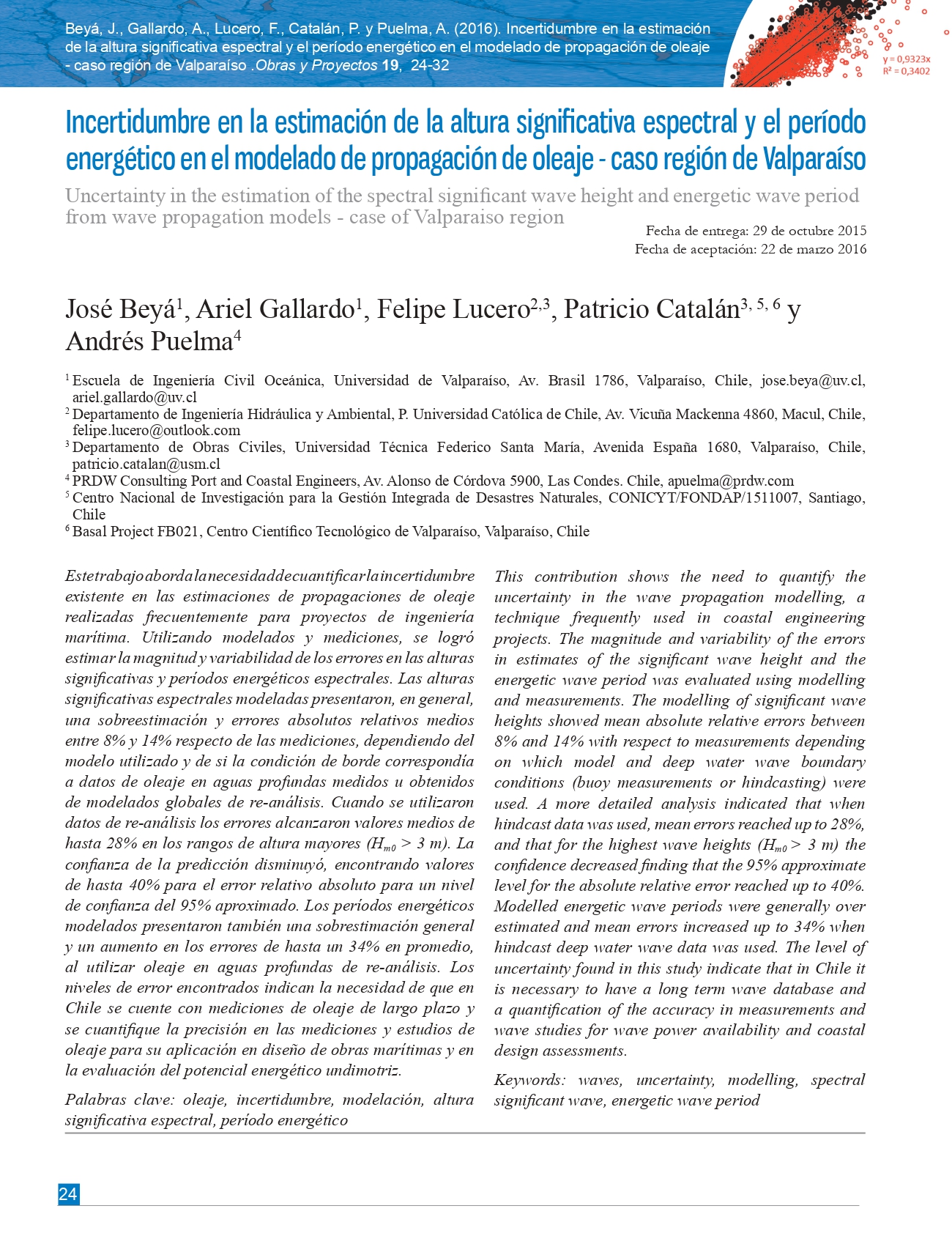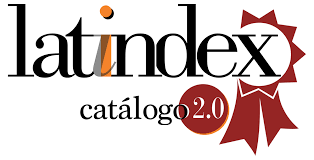Uncertainty in the estimation of the spectral significant wave height and energetic wave period from wave propagation models - case of Valparaiso region
DOI:
https://doi.org/10.4067/S0718-28132016000100002Keywords:
waves, uncertainty, modelling, spectral significant wave, energetic wave periodAbstract
This contribution shows the need to quantify the uncertainty in the wave propagation modelling, a technique frequently used in coastal engineering projects. The magnitude and variability of the errors in estimates of the significant wave height and the energetic wave period was evaluated using modelling and measurements. The modelling of significant wave heights showed mean absolute relative errors between 8% and 14% with respect to measurements depending on which model and deep water wave boundary conditions (buoy measurements or hindcasting) were used. A more detailed analysis indicated that when hindcast data was used, mean errors reached up to 28%, and that for the highest wave heights (Hm0 > 3 m) the confidence decreasedfinding that the 95% approximate level for the absolute relative error reached up to 40%. Modelled energetic wave periods were generally over estimated and mean errors increased up to 34% when hindcast deep water wave data was used. The level of uncertainty found in this study indicate that in Chile it is necessary to have a long term wave database and a quantification of the accuracy in measurements and wave studies for wave power availability and coastal design assessments.
References
CORFO-INNOVA (2009). Catastro del recurso energético asociado a oleaje para el apoyo a la evaluación de proyectos de generación de energía undimotriz. Proyecto CORFO INNOVA 09CN14-5718 Hydrochile, INH, PUC, PRDW, UV, UTFSM.
Cruz, J. (2008). Ocean Wave Energy, Current Status and Future Perspectives. Springer.
DHI (2016). MIKE 21 wave modeling - MIKE 21 spectral waves FM short description. https://www.mikepoweredbydhi.com/products/mike-21 (24/01/2016).
Domínguez, J.C., Cienfuegos, R., Catalán, P.A., Zamorano, L.R. and Lucero, F. (2014). Assessment of fast spectral wave transfer methodologies from deep to shallow waters in the framework of energy resource quantification and wave forecasting in the Chilean coast. Coastal Engineering Proceedings 1(34), 23-33. https://doi.org/10.13140/2.1.2705.6647
Gallardo, A. (2015). Calibración y validación del modelo STWAVE mediante mediciones y modelación matemática en un sector ubicado en la región de Valparaíso. Memoria de título, Universidad de Valparaíso
Hoitink, A. and Schroevers, M. (2004). Validation of ADCP surface wave measurements in a shelf sea. OCEANS ‘04. MTTS/IEEE TECHNO-OCEAN ‘04 (Volume:3 ). http://dx.doi.org/10.1109/OCEANS.2004.1406333
Kabiling, M.B. and Odroniec, K.M. (2010). Calibration and verification of a MIKE21 model for evaluating shoreline stabilization alternatives. Proceedings of the International MIKE by DHI Conference, Copenhagen 2010 http://www.dhigroup.com/upload/publications/mike21/Kabiling_2010.pdf.
Lucero, F. y Catalán, P. (2014). Caracterización del potencial energético del oleaje en la costa de Chile central. XXV Congreso Latinoamericano de Hidráulica, Santiago, Chile.
Lucero, F., Catalán, P. y Ossandón, A. (2013). Selección de climas de oleaje mediante métodos de agrupamiento. XXI Congreso Chileno de Hidráulica, Concepción, Chile.
Mase, H., Tsujio, D., Yasuda, T. and Mori, N. (2013). Stability analysis of composite breakwater with wave-dissipating blocks considering increase in sea levels, surges and waves due to climate change. Ocean Engineering 71, 58-65. https://doi.org/10.1016/j.oceaneng.2012.12.037
Oh, S.H., Suh, K.D., Son, S.Y. and Lee, D.Y. (2009). Performance comparison of spectral wave models based on different governing equations including wave breaking. KSCE Journal of Civil Engineering 13 (2), 75-84. https://doi.org/10.1007/s12205-009-0075-y
Rørbræk, K. and Andersen, H. (2000). Evaluation of wave measurements with an acoustic doppler current profiler. OCEANS 2000 MTS/IEEE Conference and Exhibition.
SHOA (2005). Especificaciones técnicas para mediciones y análisis oceanográficos. Publicación Servicio Hidrográfico y Oceanográfico de la Armada de Chile SHOA 3201, Instrucciones Oceanográficas N°1, 3a edición, Valparaíso
Suh, K.D., Kim, S.W., Mori, N., and Mase, H. (2012). Effect of climate change on performance-based design of caisson breakwaters. Journal of Waterway, Port, Coastal, and Ocean Engineering 138(3), 215-225. https://doi.org/10.1061/(asce)ww.1943-5460.0000126
USACE (1998). Willapa Bay, Grays Harbor, Washington and Ponce de Leon Inlet, Florida. STWAVE model validation study. Coastal and Hydraulics Laboratory, Engineer Research and Development Center Waterways Experiment Station, Vicksburg, Mississippi, USA (http://chl.erdc.usace.army.mil/)
USACE (2006). Coastal Engineering Manual. US Army Corps of Engineers.

Downloads
Published
Issue
Section
License
Copyright (c) 2016 Universidad Católica de la Santísima Concepción

This work is licensed under a Creative Commons Attribution-NonCommercial 4.0 International License.







